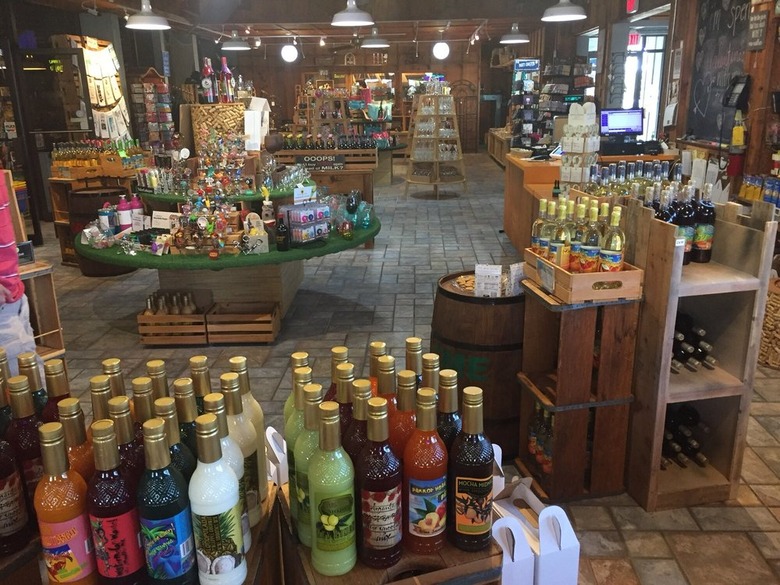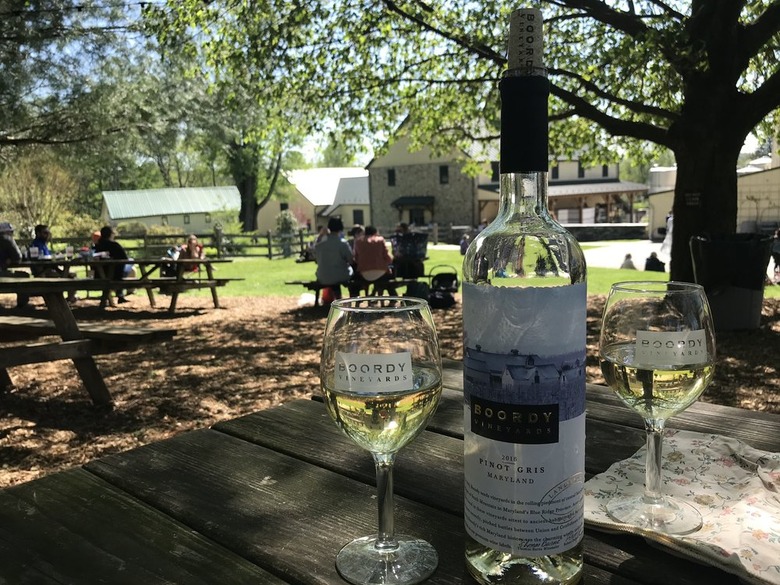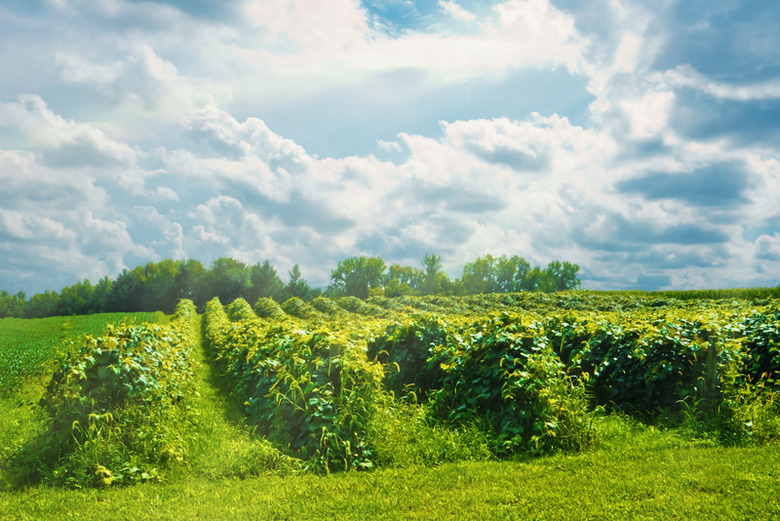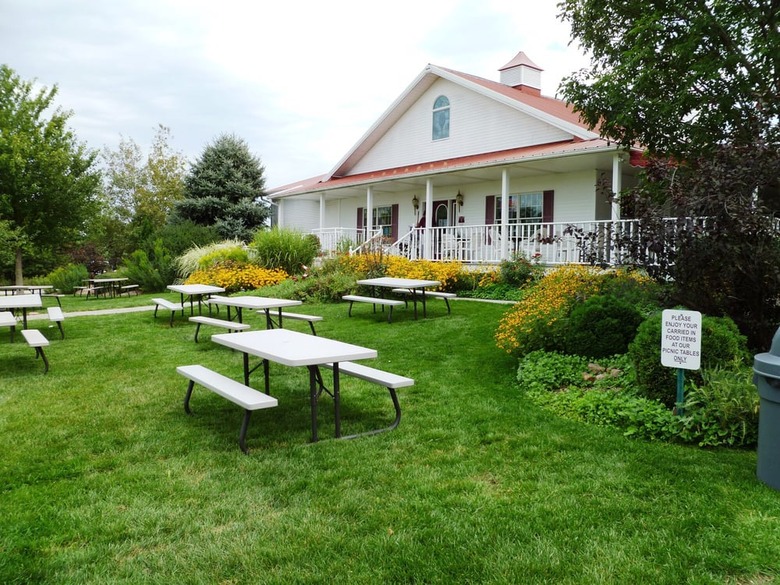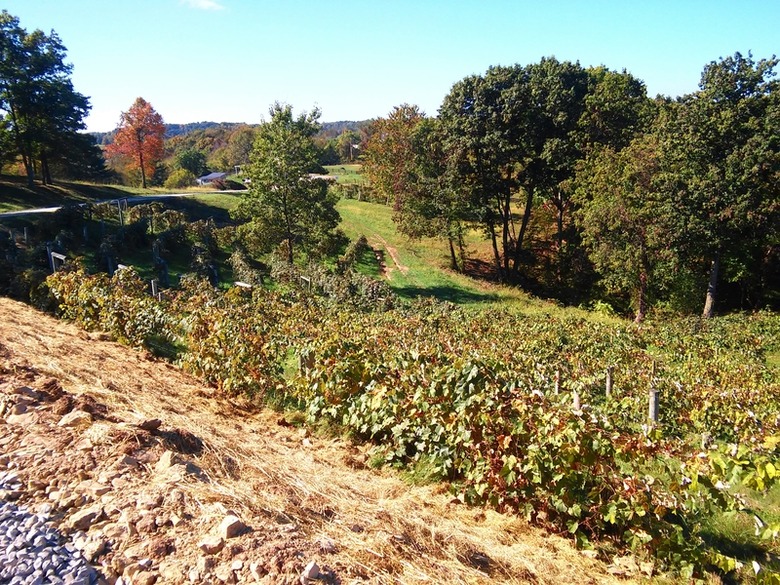We Bet You Didn't Know These States Made Wine Gallery
American wine is a $220 billion industry, responsible for over one million jobs in the country. Certain states are known for their winemaking — particularly California, which produces nearly 90 percent of all American wine. New York, Oregon, Washington, and Virginia are also known for their respective wine industries, but there are actually wineries in every one of the 50 states.
Not every one of these states has a notable wine industry, however. But there are some in particular that don't get as much recognition as they should for their winemaking. You may not have realized, for example, how successful some of the wines in Idaho are or that Colorado has a pretty serious winemaking industry as well. (So serious, in fact, that they've even made wine for cats!) Both Texas and Arizona have growing winemaking industries that aren't often talked about. And those are just a few of the states that we bet you didn't know made wine.
Alaska
Where there's a will, there's a way. Alaska's wine country centers around the southern part of the state, in Anchorage, Homer, and on Kodiak Island. Alaska's climate doesn't support grape-growing, but wineries (such as Alaska Denali Winery and Bear Creek Winery) import grapes from all over the country to create signature wines that are blended with native Alaskan fruit such as gooseberry, rhubarb, and blueberry.
Arizona
Arizona has three major wine regions: Verde Valley, Sonoita and Willcox. The wine industry here got its start in the 1500s as missionary Jesuit priests from Spain started to grow grapes in Arizona to make wine for their religious ceremonies. Over 100 wine cellars, vineyards, and wineries populate Arizona today.
Colorado
Wine started being made in Colorado in the 1800s, when miners brought grapevines to the southern part of the state. The Colorado wine industry has grown immensely in the past few decades, growing from five wineries in 1990 to 129 as of July 2018, and accounts for 1 percent of all wineries in the country.
Florida
The Sunshine State was actually the first place in the United States where wine grapes were grown — long before there even was a United States. Like in Arizona, Spanish missionaries in Florida started growing the crop in order to make wine for use in their religious ceremonies. Other types of wines are also made in Florida, where in 1991 Florida Orange Groves Winery started making them from 100 percent tropical fruit, including orange, mango, grapefruit, key lime, strawberry, and blueberry.
Hawaii
Thanks to the higher elevation of the volcanic mountains of Hawaii, the state has three main wineries: Oeno Winemaking on Oahu, MauiWine Vineyards on Maui, and Volcano Winery on the Big Island of Hawaii. Most wine produced here is fruit wine, like pineapple sparkling wine, but the state does produce grape wine as well.
Idaho
The very first grape vineyards planted in the Pacific Northwest were in what is now the state of Idaho. Most Idahoan wineries are located in the Snake River Valley. Idaho is known for its cool climate white wines, but there has been more of a focus on red wines in recent years as well. Ste. Chapelle Winery, located in Caldwell, actually made it to our list of 101 best wineries in America.
Illinois
Shawnee Hills was Illinois' first AVA (American Viticultural Area) and is considered Illinois' foremost grape-growing region. Shawnee Hills AVA features 11 award-winning wineries, such as Alto Vineyards, which was founded in 1982 by Guy Renzaglia, who brought new grape varietals to the region (Chambourcin and Vidal blanc). In the 1990s, he and two other growers founded the Shawnee Hills Wine Trail. Summer breezes as well as sandstone and limestone subsoil contribute to successful viticulture in this region, whose climate is similar to regions in Italy and Spain.
Indiana
Wine started being made in Indiana in the 17th century, and by the mid-19th century the state was the 10th largest grape wine producer in the country. Today, over 75 wineries operate in the state, including Oliver Winery, the oldest and largest of them.
Maryland
Winemaking started as early as the year 1648 in Maryland, but it wasn't until 1662 that the first grapes from Europe were planted along the St. Mary's River. Boordy Vineyards, the first actual winery in Maryland, opened 283 years later in 1945, and today the wine industry generates about $50 million of revenue every year. The Maryland Wine Festival, held every year, is one of the oldest and largest of its kind on the East Coast, with over 25,000 people in attendance and over 150 Maryland wines featured.
Michigan
Sweet wines are the traditional varietals in Michigan's winemaking industry, although the state does produce grape wines as well. Michigan is also one of the leading producers of fruit wines, particularly cherry wine, and the state's climate also allows for production of ice wine.
Missouri
Missouri's wine corridor is sometimes referred to as the "Missouri Rhineland" on account of the fact that it was German immigrants who established the first vineyards and wineries there in the early 1800s. By the mid-1880s, Missouri was producing more wine than any other state, and it was the second largest wine producer until Prohibition. Today, there are more than 130 wineries in Missouri, many of which can be visited on one of the state's 11 unique wine trails.
Nebraska
Though corn remains Nebraska's agricultural queen, French-American grape hybrids and American varietals love the Cornhusker State's soil and climate. Winter-hardy grapes with shorter growing seasons, like vignoles and edelweiss, are fit to survive Nebraska's harsh winters, which can dip 20 to 30 degrees below zero. The edelweiss varietal has a sweet to semisweet flavor profile, and is the most widely grown grape in Nebraska. James Arthur Vineyards, located just north of Lincoln, is Nebraska's largest winery and has won multiple awards for their edelweiss blends.
New Jersey
New Jersey's winemaking industry started in the 1700s, when two men — Edward Antill and William Alexander, Lord Stirling — planted grapes and produced wine due to a cash incentive given to the North American colonies by the Royal Society of Arts in London. Today, there are more than 50 wineries in the state and much of the wine produced is of the non-grape variety, instead using other fruits like apple, blueberry, cranberry, and raspberry wine. The industry contributes about $30 million to the state's economy annually.
New Mexico
New Mexico is yet another state whose wine industry began due to the need for wine to be used in sacraments of the church. The first vineyards were planted in the Río Grande valley in 1629 by a Franciscan friar and a Capuchín monk. The grape varietal they initially planted is known today as the mission grape, and can still be found today growing vineyards across the Land of Enchantment.
North Carolina
North Carolina is actually the seventh largest producer in the country of both grapes and wine, and is one of the nation's most visited states for wine tourism. Produced since the 1800s, North Carolina wine comes from more than 175 wineries, and the state boasts five AVAs (American Viticultural Areas).
Ohio
The first wine grapes were planted in Ohio in 1823 by Nicholas Longworth, considered by many to be "the Father of American Grape Culture." It took just a few decades for Ohio to become the largest wine-producing state, with Cincinnati being the most important city in the American wine trade. The Ohioan wine industry, like in other states, took a hit during Prohibition, but continues to be one of the top wine producers today, with over 225 wineries in operation.
Pennsylvania
Pennsylvania is the 10th largest wine producing state, with three main wine regions: Lehigh Valley, Lancaster Valley, and Lake Erie. The first Pennsylvania vineyard was planted in 1683, and it was actually near Philadelphia that the Alexander grape — a type of grape from which the first American commercial wines were made — was discovered in 1740. The state produces nearly 10 million cases every year from over 275 wineries.
Texas
Franciscan priests are also responsible for the Texan wine industry, having planted the first grape vines near modern-day El Paso in the 1650s, making Texas one of the oldest wine-producing states. If you're a lover of French wine, you have Texas to thank, as the state's vines were used in research that found rootstock immune to the phylloxera epidemic that decimated European vineyards in the late 19th century.
Texas has over 300 wineries today and produces nearly 2 million cases of wine, making it the fifth largest wine producer right behind California, New York, Washington, and Oregon. Texas Hill Country is the country's second-most visited AVA, right behind Napa Valley. Don't mess with Texas wine, but to take the ultimate culinary tour of the country, we're pleased to present our complete guide to the best food and drink in every state.
More From The Daily Meal:
20 Reasons Why You Should Drink a Glass of Wine Every Day
The 101 Most Iconic Restaurant Dishes in America
35 Tourist Trap Restaurants That Are Actually Really Good
101 Best Beers in America
The Most Popular Fast Food Secret Menu Items Ever
